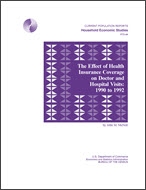
An official website of the United States government
Here’s how you know
Official websites use .gov
A .gov website belongs to an official government organization in the United States.
Secure .gov websites use HTTPS
A lock (
) or https:// means you’ve safely connected to the .gov website. Share sensitive information only on official, secure websites.
-
//
- Census.gov /
- Library /
- Publications /
- Effect of Health Insurance on Doctor and Hospital Visits: 1990-1992
The Effect of Health Insurance Coverage on Doctor and Hospital Visits: 1990 to 1992
The Effect of Health Insurance Coverage on Doctor and Hospital Visits: 1990 to 1992
Introduction
This report presents data from the Survey of Income and Program Participation (SIPP) on two primary measures of the utilization of health care services: doctor visits and nights spent in a hospital.
The purpose of the report is to examine the relationship between the utilization of health care services and selected other characteristics including health insurance coverage status. Relationships are examined using a series of cross tabulations as well as statistical models. An analysis of the relationship between two variables (e.g., age and doctor visits) may reach different conclusions depending on whether the analysis is based on cross tabulations or on statistical model results. The former provides information on the gross relationship between the variables while the latter describes the relationship net of the effect of the other variables in the model.
Data for this study were obtained from the first six waves of the 1990 SIPP panel and cover a 24-month period. Interviews for the 1990 panel were conducted during the months of February, March, April, and May 1990, and every four months thereafter. The panel had a total of eight waves. A health care utilization topical module was included in wave 3 and wave 6 and contained questions for persons 15 years old and over on doctor visits and nights spent in a hospital during the previous 12 months. (See the section on ‘‘DATAISSUES’’ for a discussion of how the measure of doctor visits used in this study differs from the measure obtained in the National Health Interview Survey.) Waves 3 and 6 also included a topical module which obtained information on health status and disability status. Information on health insurance coverage status and on certain other variables used in this report was collected in each wave.
All demographic surveys, including the Current Population Survey (CPS) and SIPP, are affected by undercoverage of the population. This undercoverage results from missed housing units and missed persons within sample households. Compared to the level of the 1980 decennial census, overall undercoverage in SIPP is about 7 percent. Undercoverage varies with age, sex, and race. For some groups, such as 20 to 24 year old Black males, the undercoverage is as high as 27 percent compared to the census. It is important to note that the survey undercoverage is in addition to the decennial census undercoverage, which in 1980 was estimated to be about 1 percent overall and about 8.5 percent for Black males. The weighting procedures used by the Census Bureau partially correct for the bias due to undercoverage. However, its final impact on estimates is unknown.
Others in Series
Publication
Publication
Publication
Share
Related Information
Some content on this site is available in several different electronic formats. Some of the files may require a plug-in or additional software to view.
 Yes
Yes
 No
NoComments or suggestions?


Top

